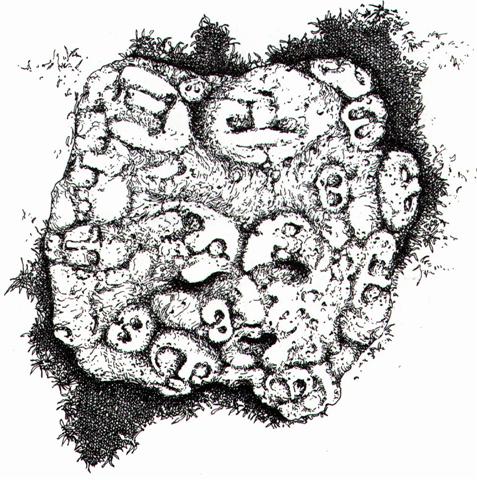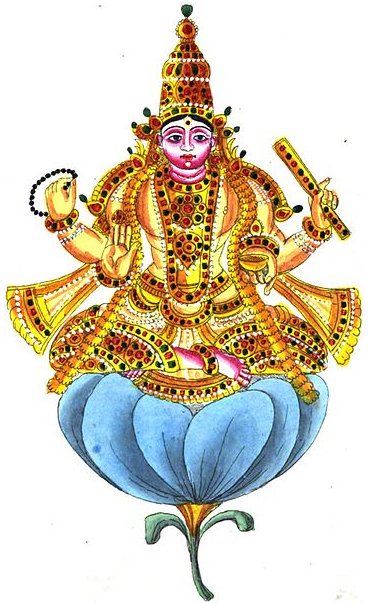3. Let's include the Fly stars, using these facts from Wikipedia:
"Bharani ... is the second nakshatra in Hindu astronomy, corresponding to 35, 39, and 41 Arietis. In Jyotisha, Bharani is ruled by Shukra (the planet Venus). Also, it is classified as a Cruel or Active nakshatra, meaning that, under electional astrological beliefs, works of a harmful or deceptive nature are best conducted while the moon is Bharani. Bharani is seen as being under the domain of Yama, the god of death or Kālī. The symbol of Bharani is the Yoni, a representation of the female sexual organ."
I have reduced the current declination values for the Fly stars with 14' (= 23º 28' - 23º 14' N for Hamal) in order to reach the time of observation according to my astronomy book. Aries is slowly sinking. The number of stars in the 3rd hour now has become 8:
If the head depicted upside down in Gb8-7 should refer to the Fly's head, then the upper part of the sign (gagana) becomes the rest of the Fly, because it is the same entity. The 'wing' in front (and slightly lower down) will be the left wing of the Fly and from it is generated offspring (hua). For technical reasons I once decided not to classify Gb8-6--7 as examples of glyphs with hua but as glyphs with hipu signs. The main difference between these (as I defined it) is the 'arm' from where the 'fruit' is hanging down, which is not present in the hipu type:
In hindsight I think the presence of a 'nipple' at bottom might have been a better choice. What is a takaure wing if not an arm? By recognizing the left part of Gb8-7 as Musca it is possible to define the central part of the glyph as a variant of hua. The connection between Venus and Bharani makes my identification of Musca with Gb8-7--8 not only possible but even probable. At Tagata Gagana I suggested the gagana sign could refer to either Saturn or Venus: ... The following picture of a sculptured stone (copied from Van Tilburg) was said to represent the multiple faces of Makemake:
The Makemake death skull presumably represents Saturn ... Only by death can new life be possible, otherwise earth would soon be overcrowded. The Maya sign said to represent Venus is quite similar to the face of Makemake, cfr 3 + 1 of them in the cartouches below:
If Gb8-7--8 is ruled by Venus (Shukra) then the position in the text - 50 days beyond glyph number 400 - could correspond to the black period between her morning and evening appearances.
"Shukra is etymologically identical with Shukla 'white'. (Wikipedia) However, I prefer instead to rely on all earlier clues which have lead me to conclude that the beginning of side a corresponds to the front side of the text and therefore should rather be in harmony with the morning star Venus than the evening star. From Acamar to the end of side b there are 3 weeks and from the beginning of the front side to tagata gagana there are 12 days, i.e. 21 (maybe as in 21 December) + 12 (21 reversed) = 33 days:
... Under Mosaic law, a mother who had given birth to a man-child was considered unclean for seven days; moreover she was to remain for three and thirty days 'in the blood of her purification', which makes a total of 40 days ...
But we should also contemplate the following facts: "January 12 is the 12th day of the year in the Gregorian calendar. There are 353 days remaining until the end of the year (354 in leap years)." (Wikipedia) "December 21 is the 355th day of the year (356th in leap years) in the Gregorian calendar. There are 10 days remaining until the end of the year. This is a frequent day for the winter solstice to occur in the northern hemisphere and summer solstice to occur in the southern hemisphere ..." (Wikipedia) At the time when I earlier saw death skull signs on the stone boulder with multiple Makemake faces as a rather sure sign of Saturn I had not yet realized what a double-name means. Instead I interpreted Make-make as an intensification of the single make:
Although without any proof whatsoever I also considered make as a variant of mate, because the difference could not have any deeper significance, otherwise the Hawaiians could not have eliminated the consonant 't' and used 'k' instead. I still do believe so. But now I read Makemake as the opposite of death, the other side of the coin so to say. Venus is the 'star' of life and thus Bharani, the left (front) wing of the Fly, should represent the morning star. |
|||||||||||||||||||||||||||||||||||||||||||||||||||||||||||||||||||||||||||||||||||||||||||||||||||||||||||||||||||||||||||||||||||||||||||||||||||||||||||||||||||||||||||||||||||||||||||||||||||||||||||||||||||||||

















